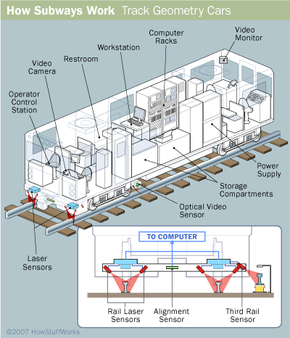Running and Maintaining a Subway
Most subway trains run along rails that have been in place for years, sometimes since the subway opened. Weather and daily wear and tear take their toll on the tracks. The rails of the New York City subway, for instance, are made from 39-foot (11.8-meter) lengths of carbon steel. Each rail is 5.5 inches (13.9 centimeters) high and 2.5 inches (6.35 centimeters) wide. Trains weighing as much as 400 tons (362.8 metric tons) run along these rails 24 hours a day, every day. In addition, the record temperatures range from 24 degrees Fahrenheit (-4 degrees Celsius) in January to 102 degrees Fahrenheit (39 degrees Celsius) in July [Source: BBC Weather]. Sections of track exposed to the elements encounter rain, snow, sleet and other precipitation every year.
All of these factors can affect the rails' surface and alignment. If the rails deteriorate or shift, the trains could derail as a result. For this reason, transit employees have to constantly monitor the state of the rails. To do this, they use a geometry train.
Advertisement
Railway and subway systems around the world use some type of geometry train to keep an eye on the tracks. These are cars that travel along the tracks, using lasers mounted to the front and underside to take precise measurements of the rails. In New York, the geometry train runs nonstop. Employees ride inside, analyzing the measurements and ordering repairs for any section of track that is more than 1.25 inches (3.1 centimeters) out of alignment.
The geometry train can also help employees prevent fires within the subway tunnels. Litter or other debris near the subway tracks can catch fire, quickly filling a tunnel with smoke. To prevent this, employees use infrared sensors to pinpoint hotspots near the rails. They use fire extinguishers to remove any threat of fire.
The employees who monitor the rails from the geometry train are only a few of the people required to keep a subway system running. Virtually every subway system also employs custodial, security and emergency medical staff. Systems with automated trains employ supervisors to work from the control room, and systems with manually operated trains employ both operators and control-room staff. In addition, subways have a management staff to create and implement a budget for running the subway and to coordinate renovations and expansions.
Many subways are not financially self-sufficient and must rely on government support to stay in business. In New York, for example, only about half of the money required to run the subway comes from riders' fares. For this reason, keeping a subway running involves careful interaction between government agencies and approval processes for planned upgrades.
We'll take a look at expansions and threats to subway systems in the next section.
